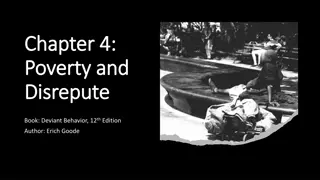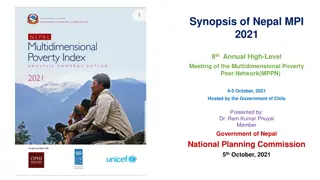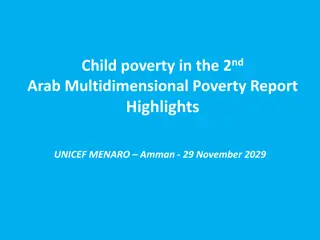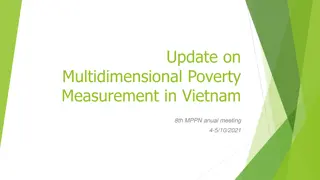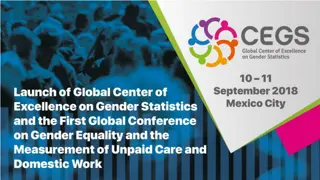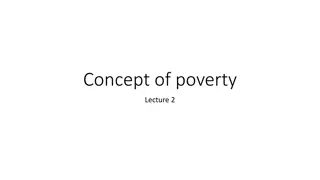Choices in Measurement Design and National Poverty Assessment
This content discusses normative choices in measurement design, normative reasoning, relevance, usability, essential choices for creating an Alternative Poverty Measure (AF Measure), alongside measurement design considerations, and a purpose statement for a National MPI. It emphasizes the importance of deliberative insights, empirical and theoretical assessments, and practicality in measurement design, along with the governance structure for implementing national poverty assessment. Key aspects include space considerations, authority, legal basis, internal processes, and political factors.
Download Presentation

Please find below an Image/Link to download the presentation.
The content on the website is provided AS IS for your information and personal use only. It may not be sold, licensed, or shared on other websites without obtaining consent from the author.If you encounter any issues during the download, it is possible that the publisher has removed the file from their server.
You are allowed to download the files provided on this website for personal or commercial use, subject to the condition that they are used lawfully. All files are the property of their respective owners.
The content on the website is provided AS IS for your information and personal use only. It may not be sold, licensed, or shared on other websites without obtaining consent from the author.
E N D
Presentation Transcript
Normative Choices in Measurement Design M nica Pinilla-Roncancio
Normative Reasoning: High Level ~ Meta ~ Coordination Coordinates insights from different analyses of measurement to rule out suboptimal options and select among justifiable options. Deliberative insights Empirical assessment Practicalities Expert assessment Theoretical assessment Policy relevance
Relevance and Usability (Sen 1987 : 20) Relevance : demands we consider the complexities of the living standard Usability : we try synthetize, simplify, restrain complexity
Eight Essential Choices for your own AF Measure: 1. Purpose 2. Space 3. Unit of Identification or Analysis 4. Dimensions (if helpful) 5. Indicators - columns in the matrix 6. Deprivation Cutoffs for each Indicator 7. Weights/Values for each Indicator 8. Poverty cutoff to identify the poor 9. Identification (who is poor) 10. Aggregation (How much poverty does a society have)
Alongside measurement design: 1. Process 2. Authority 3. Legal/institutional basis 4. Update 5. Incentives 6. Politicalconsiderations
Purpose Statement of a National MPI The national poverty measure aims to assess the population-wide progress in capability poverty reduction every two years across states, rural-urban regions, ethnic and religious groups, in ways that are regarded as legitimate and accurate by the citizenry. The measure shall be disseminated across the public sector, NGOs, and academic institutions among others. Results will be communicated widely to citizen and social groups. Data and Governance (data, authority, procedures) The measure will use a newly-designed survey, to be fielded every two years. The National Statistics Bureau (NSB) has the authority to implement the survey, construct the measure, and release it as an official statistic. The NSB can propose to update the methodology roughly once per decade. A cross- institutional working group can be constituted to propose changes to the Statistical Advisory Council for approval. 6
2. Choice of Space Could be: 1. Resources (Consumption/Assets) 2. Access to services in theory 3. Using services 4. Functionings and capabilities 5. Subjective utility Most MPIs use 3) or 4) - outcomes Money for healthcare Health clinic exists Go to clinic Have good health Happy with health status
2. Choice of Space in Practice 1. Choose your ideal space 2. When you have outlined trial measures go back to each indicator. 3. Write out which each indicator is a functioning/outcome, output, input etc. 4. If they are different spaces, can you adjust them to be more coherent? 5. Do the best you can it s all we can do.
3. Unit(s) of Identification and Analysis Unit of Identification: Who is identified as poor or non- poor (poverty status) Examples: Person - Child Household Choice depends upon data, and purpose. The unit of analysis: how data are reported (preferred: percentage of population who are poor)
Choosing your Unit(s) in practice? How do I decide? - Are there comparable indicators for All Persons (by age, gender, etc) - E.g. for Children: indicators for babes and teens? Most National MPIs use household as unit of identification, because data needs are less demanding Child MPIs have individual child as the unit.
4. Choice of Dimensions The need for selection and discrimination is neither an embarrassment, nor a unique difficulty . (Sen 2008). Dimensions refer to conceptual categorizations of indicators for ease of communication and interpretation of results. Confusion prevention note: in AF JPubE 2011, indicators are termed dimensions
Key Inputs into Choice of Dimensions Existing Data Deliberative/participatory exercise Theory: Well-being, Rights, etc Enduring public consensus Law, National Development Plan SDG Priority areas Normally use a combination of inputs
5. Choice of Indicators: -Purpose shapes indicator requirements -Indicators must be clear: (Atkinson and Marlier, 2010, 8 14) - essence of the problem - agreed normative interpretation - statistically robust. - show direction of change (not stock) - be susceptible to revision [every 10 years] - should not impose too large a burden on countries
5. Choice of Indicators: General 1. Reflects people s ideas of MD poverty 2. Policy Relevant can be changed by policy 3. Relevant in Institutional/Historical Setting 4. Can be interpreted 5. Can be communicated 6. Data are good quality 7. Survey Cost is affordable
5. Choice of Indicators: Required: 1. Representative of deprivations for each unit of identification? (reference period, accuracy, volatility) 2. Converted to reflect the unit of identification (individual, hh) 3. Clear understanding of Non-Applicable populations (rare event, demographics) 4. Avoid Subjective data due to common issues: 1. Trends over time may not reflect objective trends 2. Representative of household? Sample design? 3. Accuracy over time may be weak
6. Deprivation Cutoffs Deprivation cutoffs define a minimum level of achievement, below which a person is deprived in each indicator Deprivation cutoffs are a distinguishing feature of multidimensional poverty measures that reflect the joint distribution of deprivations. Bourguignon and Chakravarty 2003 Clearly matter fundamentally: -Affect uncensored headcount ratio & effective weights -Define possibility to be identified as poor -Results may be sensitive to choice
6. Choice of Deprivation Cutoffs z Purpose of the MPI (moderate, acute, both?) Participatory exercises how much is enough Data: Response structures and possibilities Legal documents (compulsory schooling) Plans, Goals, Targets (aim = ante-natal care) Empirical examination of data/ robustness Possible use of two cutoff vectors (destitution)
7. Weights reflect value judgments Early critics focused on the weights Claiming they cannot be set in a defensible way Claiming disputes on weights undermine legitimacy of measure Prefer a mechanical route PCA/regression coefficients/prices The 2010 debate clarified: Weights are normative Weights are essential and not embarrassing to set Weights of MPI (values) are NOT like weights on HDI Robustness tests on weights are essential Measures must be robust to a plausible rangeof weights 18
Weights weights (also called deprivation values) reflect the relative impact that the presence or absence of a deprivation has on the person s deprivation score and thus on their identification, and, for poor people, on poverty. It is thus crucial to ask, in any evaluative exercise how the weights are to be selected., in arriving at an agreed range for social evaluations (e.g. in social studies of poverty), there has to be some kind of a reasoned consensus on weights or at least on a range of weights. This is a social exercise and requires public discussion and a democratic understanding and acceptance (AFSSRB 2015) Sen 1996:397
8. Poverty Cutoff: The cross-dimensional poverty cutoff k identifies each person as poor or non-poor according to the extent of deprivations they experience, which are summarized in their deprivation score. It is similar to the poverty line in income space (but set across deprivation scores more is worse)
8. Poverty Cutoff: A value judgment: How much is enough to be poor? Often political interest because it creates the H Has been justified by, or set to reflect: A participatory or subjective assessment A legal definition (Mexico) Policy promises Ease of Communication most common Robustness most common Select from a short menu of options most common
Eight Essential Choices for your own AF Measure: 1. Purpose 2. Space 3. Unit of Identification or Analysis 4. Dimensions (if helpful) 5. Indicators - columns in the matrix 6. Deprivation Cutoffs for each Indicator 7. Weights/Values for each Indicator 8. Poverty cutoff to identify the poor 9. Identification (who is poor) 10.Aggregation (How much poverty does a society have)
Practical Steps Select Purpose of the index (monitoring, targeting, etc.) Unit of analysis (people, households, countries) Dimensions Specific indicators for each dimension Cutoff for each indicator Weight for each indicator Poverty cutoff Identification: who is poor? Aggregation: how much poverty is there?
25 How to Compute the MPI The MPI is the product of two components: MPI= H A 1) Incidence (H)~ the percentage of people who are poor. 2) Intensity(A) ~ the percentage of indicators in which poor people are deprived, on average. The MPI is can be decomposed by groups & broken down by indicators Alkire and Foster Journal of Public Economics 2011
Alkire-Foster methodology (to simplify we assume equal weights in this example) Matrix of deprivation scores for 4 persons in 4 dimensions Who is deprived in what? Years of Education ND ND D Housing Index ND ND D Mal- Health nourished ND D D ND D D Chris John y = Monica Emma ND D ND ND
Alkire-Foster methodology (to simplify we assume equal weights in this example) Matrix of deprivation scores for 4 persons in 4 dimensions How much? Years of Education ND ND D Housing Index ND ND D Mal- Health c nourished ND D D ND D D 0 2 y = 4 1 ND D ND ND
Alkire-Foster methodology (to simplify we assume equal weights in this example) Who is poor? Fix poverty cut-off k, identify as poor if ci >= 2 Years of Education ND ND D Housing Index ND ND D Mal- Health c nourished ND D D ND D D 0 2 y = 4 1 ND D ND ND Multidimensional Poverty Headcount (H)= 2/4 [50% of the population are poor]
Alkire-Foster methodology (to simplify we assume equal weights in this example) Who is poor? Fix poverty cut-off k, identify as poor if ci >= 2 Years of Education ND ND D Housing Index ND ND D Mal- Health c nourished ND D D ND D D 0 2 2/4 y = 4 4/4 1 ND D ND ND Intensity of deprivation among the poor (A)=(2/4+4/4)/2= 3/4 [on average, the poor are deprived in 75% of the dimensions]
The MD Poverty Index Years of Education ND ND D Housing Index ND ND D Mal- Health c Av. dep nourished ND D D ND D D 0 2 2/4 4 4/4 1 ND D ND ND Multidimensional Poverty Headcount (H)= 2/4 = 50% Intensity of deprivation among the poor (A)=(2/4+4/4)/2= =75% MPI = H x A = (2/4)x(3/4) = 6/16 = 0.375
The MD Poverty Index INTERVENTION Years of Education ND ND D Housing Index ND ND D Mal- Health c Av. dep nourished ND D D ND D D 0 2 2/4 4 4/4 1 ND D ND ND Multidimensional Poverty Headcount (H)= 2/4 = 50% Intensity of deprivation among the poor (A)=(2/4+4/4)/2= =75% MPI = H x A = (2/4)x(3/4) = 6/16=0.375
The MD Poverty Index INTERVENTION Years of Education ND ND D Housing Index ND ND D Mal- Health c Av. dep nourished ND D ND ND D D 0 2 2/4 3 3/4 1 ND D ND ND Multidimensional Poverty Headcount (H)= 2/4 Intensity of deprivation among the poor (A)=(2/4+3/4)/2= 5/8 = 62.5% MPI = H x A = (2/4)x(5/8) = 10/32=0.3125




